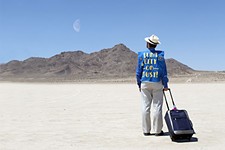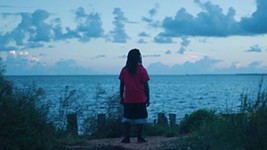Flight Patterns
The Texas Documentary Tour: Judy Irving's 'The Wild Parrots of Telegraph Hill'
By Anne S. Lewis, Fri., Sept. 9, 2005

Whenever I read a rave review of a "nature film," like The Wild Parrots of Telegraph Hill, with its implicit/explicit promise that this film is about far more than a flock of parrots and their eccentric "whisperer," I'll usually think, yeah, I should see that. Someday. And sometimes I do – saw the penguin film, saw Grizzly Man – but, despite my best intentions, I never made it to the parrot movie when it was at the Dobie. Big mistake. I'll stop before I begin waxing about how it's so much more than a film about a bunch of cherry-headed conures, other than to say that probably no one was more surprised by the way the film turned out than its Bay area filmmaker, Judy Irving (Dark Circle).
Irving first read about Mark Bittner in a pet-parrot magazine, a story about how the quiet, contemplative, long-haired hippie who lived by himself in a run-down shack on San Francisco's Telegraph Hill and ministered to this flock of non-native, escaped-pets-now-wild-parrots would soon have to vacate his rent-free home because the property owners were renovating. What started out as a hobby film to use up a few rolls of film left over from another shoot because she "didn't think there was much 'story' in a guy feeding a bunch of birds" took a few tentative steps into a half-hour children's fable when she discovered the birds "were colorful and feisty and Mark had a good voice" – though she still didn't believe that he could "hold the screen" on his own.
The children's fable concept turned out to be a nonstarter when the acting was flat and she couldn't keep the kids from looking at the camera. Then, Irving explains, listening to Bittner's stories about the individual birds – from the social travails of Connor, the lonely blue-crowned conure to the cuddling pair, Picasso and Sophie, to Pushkin, a single father who raises three babies on his own – she realized that he was a great storyteller.
"I started to see past my own blinders and realized that he was articulate, funny, relaxed in front of the camera," she recalls, "and interesting in his own right."
Rather than a mere homeless parrot-whisperer who might or might not have been anthropomorphizing the intrafamilial and social lives of a flock of parrots, Bittner was what the San Francisco beat poet Gary Snyder called a "dharma bum," a homeless seeker of truth. Filming him during his sixth and final year with the parrots before moving, Irving realized that she had a fully structured film right under her nose: "Mark being on the brink of having to leave, then actually having to leave, gave me a dramatic arc with a beginning, middle, and end." Even better, the film turned out to have a real-life happy ending: Earlier in the film, Bittner explains that he'd determined not to cut his waist-length hair until he had a girlfriend. At the end of the film, we watch Bittner's pony tail get scissored off and held up like a pelt. You'll have to see the movie to see who joins the dharma bum in the next frame.
Austin Chronicle: Are you surprised by the popularity of your film? Do you think it's pure coincidence or a shift in the public's taste for nature docs that first Wild Parrots, then the penguin film, and, most recently, Grizzly Man have had such broad appeal?

Judy Irving: Surprised? Yes. Pleased? Yes! We're slowly moving up toward $3 million in ticket sales, which represents Wild Parrots flying to about 450 theatres nationwide. I had no idea that Penguins or Grizzly were coming down the pike, as I'm sure they didn't know about Parrots. Sometimes it works that way though, as when scientists make the same discoveries in different parts of the world at the same time. Obviously we're all ready for something different from and better than what Hollywood has been producing. It doesn't help that most of those films are aimed at teenaged boys.
AC: When you began the film, did you think it would be more about the parrots or more about Mark or both?
JI: As I moved into the documentary portrait structure, I knew that I wanted the film to be as much about Mark as about the parrots. I was interested in the relationship between Mark and the flock, and in what the flock taught him over time about consciousness, finding one's path, and right livelihood. That parrots could teach these things was a surprise to both of us – to him, because he'd always thought of them as a diversion, and to me, because I didn't know how much they would alter his life.
AC: Have audiences seemed to come away from the film with what you'd hope they would?
JI: One thing I'd hoped for was that city people would look up, look around at the nature that surrounds them. And I have had lots of feedback that this is what often happens. I've also hoped that the film would give people encouragement to follow their hearts, follow the path that seems right for them, no matter how difficult that is. This has happened, too. One woman quit selling real estate after seeing the film, and went back to being an artist. Someone else talked about how the film gave her hope that she would still find someone, even though she was in her 50s. I've hoped that Mark's example would encourage people to treat animals that are in their care – including lab animals – with more understanding and respect. People who own parrots see a lot of the same behaviors in the wild flock, and it gives them a larger sense of who their pet is. Mark developed a broader understanding of consciousness by including the animal world, not just the human world, in his thinking, and he developed ideas about death that grew from this understanding. The "Zen Waterfall" story is central to the film, and many people have told us that it gives them a sense of peace when thinking about the death of a loved one, animal or human, as well as when thinking about their own deaths. Since this story also helped me understand death better, it's very satisfying to hear that it does the same for others.
AC: Given the way the conceptualization of your film evolved, was there anything that you would have done differently?
JI: Fellini once said that he wouldn't have done anything differently because if he had, the final film would be different. What he meant by that was that he accepted the process of making the movie as it happened, with the blind alleys, blunders, mistakes, missed shots, and rethinking all there and all fine. It's the process that ultimately produced the movie. I feel the same way.
AC: The film was shot so beautifully – and on film. Beyond the colorful parrots, you've really captured the sensual essence and feel of the city.
JI: For 32 years, my whole life as a filmmaker, I've shot 16mm film. When I was collaborating with Chris Beaver, we shared the shooting and sound-recording tasks, but because he was a better cinematographer I deferred to him and often recorded sound. I always loved shooting, though, and I was glad to get back into practice on this film. [There were several cinematographers who worked on Parrots.] My gear consists of an ancient Eclair NPR and a Bolex windup camera. It's heavy, but it produces beautiful images, and I've resisted the lure of lightweight video because I shoot mostly outdoor environmental and nature films, and it simply looks better than DV. ![]()
The Wild Parrots of Telegraph Hill screens as part of the Texas Documentary Tour on Wednesday, Sept. 14, 7pm, at the Alamo Drafthouse South Lamar. Judy Irving will participate in a Q&A after the screening. Tickets ($4 for Austin Film Society members and students, and $6 for nonmembers), are available through the AFS (www.austinfilm.org) or at the venue one hour prior to screening.










